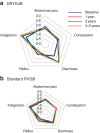Effect of different limb lengths on quality of life, eating patterns and gastrointestinal symptoms after Roux-en-Y gastric bypass in superobese patients: randomized study
- PMID: 32931641
- PMCID: PMC7709371
- DOI: 10.1002/bjs5.50334
Effect of different limb lengths on quality of life, eating patterns and gastrointestinal symptoms after Roux-en-Y gastric bypass in superobese patients: randomized study
Abstract
Background: Distal Roux-en-Y gastrojejunal bypass (DRYGJB) gives better weight reduction than standard Roux-en-Y gastric bypass (RYGB) but at the risk of increased malnutrition side-effects. This study compared the effects of RYGB and DRYGJB on gastrointestinal symptoms, eating patterns and health-related quality of life (QoL).
Methods: This was a single-blind RCT from a university-affiliated obesity centre. Patients with a BMI of 50 kg/m2 or above were invited to participate. Treatment arms were standard gastric bypass with an alimentary limb of 150 cm and a biliopancreatic limb of 60 cm, with a variable common channel length, or DRYGJB with biliopancreatic limb of 200 cm, common channel limb of 150 cm and variable alimentary limb length. Baseline and follow-up data to 5 years on quality of life, obesity-related problems and gastrointestinal symptoms were collected using prospectively created and validated questionnaires.
Results: Some 140 patients were included. Those with a DRYGJB had better weight loss at 5 years (mean(s.d.) 68·3(21·8) kg versus 55·7(19·8) kg for standard RYGB; P = 0·011). Eating patterns improved, with no difference between the groups. Gastrointestinal symptoms (diarrhoea, indigestion) worsened significantly in both groups, but only patients with DRYGJB had significantly worse diarrhoea at the end of the study than at baseline (P = 0·006). Both groups had improved perceived generic QoL over baseline, and obesity-related problems were markedly reduced.
Conclusion: Standard RYGB and both improved generic and disease-specific QoL and eating behavioural pattern. Diarrhoea was increased more following DRYGJB than after RYGB. Registration number: NCT01514799 (https://clinicaltrials.gov).
Antecedentes: El bypass gastroyeyunal distal (distal gastrojejunal bypass, DRYGB) proporciona una mejor pérdida de peso que el RYGB estándar, pero con el riesgo de aumentar los efectos secundarios de malnutrición. El presente estudio comparó los efectos de RYGB y DRYGJB en los síntomas gastrointestinales, patrón alimentario y calidad de vida relacionada con la salud. MÉTODOS: Estudio aleatorizado simple-ciego y controlado efectuado en un centro de obesidad con afiliación universitaria. Se invitó a participar a pacientes con un IMC de ≥ 50 kg/m2 . Las ramas del tratamiento fueron el bypass gástrico estándar con asa alimentaria (alimentary lim, AL) de 150 cm y asa biliopancreática (biliopancreatic, BP) de 60 cm, con asa común (common cannel, CC) de longitud variable, o DRYGJB con asa BP de 200 cm, asa CC de 150 cm y AL variable. Se recogieron datos basales y de seguimiento a los 5 años respecto a la calidad de vida, problemas relacionados con la obesidad y síntomas gastrointestinales utilizando cuestionarios prospectivos creados y validados.
Resultados: Se incluyeron un total de 140 pacientes. Los pacientes con DRYGJB tuvieron una mayor pérdida de peso a los 5 años (media (DE) 68,3 kg (21,9) versus 55,7 (19,8); P = 0,011)). Los patrones alimentarios mejoraron sin diferencia entre grupos. Los síntomas gastrointestinales (diarrea, indigestión) empeoraron significativamente en ambos grupos, pero solo los pacientes con DRYGJB presentaron diarrea al final del estudio significativamente peor en comparación con la situación basal (P = 0,006). Ambos grupos presentaron una mejor percepción de la QoL genérica en comparación con el estado basal, y los problemas relacionados con la obesidad se redujeron considerablemente. CONCLUSIÓN: El bypass gástrico estándar (RYGB) y el bypass gastroyeyunal distal (DRYGJB) mejoraron la QoL, tanto genérica como la específica de la enfermedad, así como el patrón de comportamiento alimentario. El DRYGJB aumentó la diarrea más que el RYGJB.
© 2020 The Authors. BJS Open published by John Wiley & Sons Ltd on behalf of British Journal of Surgery Society.
Figures





Similar articles
-
Standard Biliopancreatic Limb (50 cm) Roux-en-Y Gastric Bypass Versus Long Biliopancreatic Limb (100 cm) Roux-en-Y Gastric Bypass in Patients with Body Mass Index 40-50 kg/m2: a Randomized Prospective Study.Obes Surg. 2022 Mar;32(3):577-586. doi: 10.1007/s11695-021-05868-y. Epub 2022 Jan 3. Obes Surg. 2022. PMID: 34981324 Clinical Trial.
-
Long-Term Outcome of Proximal Versus Very-Very Long Limb Roux-en-Y Gastric Bypass: the Roux-Limb to Common Channel Ratio Determines the Long-Term Weight Loss.Obes Surg. 2021 Mar;31(3):994-1003. doi: 10.1007/s11695-020-05109-8. Epub 2020 Nov 16. Obes Surg. 2021. PMID: 33196977
-
Conversion of standard Roux-en-Y gastric bypass to distal bypass for weight loss failure and metabolic syndrome: 3-year follow-up and evolution of technique to reduce nutritional complications.Surg Obes Relat Dis. 2018 May;14(5):554-561. doi: 10.1016/j.soard.2018.01.004. Epub 2018 Jan 31. Surg Obes Relat Dis. 2018. PMID: 29567059
-
Optimal Small Bowel Limb Lengths of Roux-en-Y Gastric Bypass.Curr Obes Rep. 2023 Sep;12(3):345-354. doi: 10.1007/s13679-023-00513-4. Epub 2023 Jul 19. Curr Obes Rep. 2023. PMID: 37466789 Review.
-
One Anastomosis Gastric Bypass Versus Roux-en-Y Gastric Bypass for Obesity: a Systematic Review and Meta-Analysis of Randomized Clinical Trials.Obes Surg. 2020 Apr;30(4):1211-1218. doi: 10.1007/s11695-019-04288-3. Obes Surg. 2020. PMID: 31749109
References
-
- Sturm R. Increases in clinically severe obesity in the United States, 1986–2000. Arch Intern Med 2003; 163: 2146–2148. - PubMed
-
- Vinciguerra F, Baratta R, Farina MG, Tita P, Padova G, Vigneri R et al Very severely obese patients have a high prevalence of type 2 diabetes mellitus and cardiovascular disease. Acta Diabetol 2013; 50: 443–449. - PubMed
-
- Hedberg J, Sundström J, Sundbom M. Duodenal switch versus Roux‐en‐Y gastric bypass for morbid obesity: systematic review and meta‐analysis of weight results, diabetes resolution and early complications in single‐centre comparisons. Obes Rev 2014; 15: 555–563. - PubMed
-
- Shah K, Nergård BJ, Fagerland M, Gislason H. Distal gastric bypass: 2‐m bilipancreatic limb construction with varying lengths of common channel. Surg Obes Relat Dis 2019; 15: 1520–1526. - PubMed
-
- Shah K, Nergård BJ, Fagerland M, Gislason H. Limb length in gastric bypass in super‐obese patients – importance of total alimentary small bowel tract. Obes Surg 2019; 29: 2012–2021. - PubMed
Associated data
LinkOut - more resources
Full Text Sources
Medical
Research Materials

